Siemens: Safety Integrated - AS-Interface
AS-Interface Safety at Work
Safe and unsafe data on one bus system - AS-Interface Safety at Work makes it possible. Safety at Work utilizes the Actuator-Sensor Interface sensor level bus system as its foundation technology. AS-Interface is an OPEN protocol standard supported by hundreds of manufacturers worldwide. Connectivity to existing PLC platforms is possible by either using a standard AS-Interface Master in the central rack or by using protocol gateways, which connect many of the popular Fieldbus technologies to AS-Interface.
Standard AS-Interface slaves and Safety rated slaves can now co-exist on the same network. Systems that have an existing AS-Interface system can be easily expanded to use Safety at Work components. All that is required for a Safety at Work system is a Safety Monitor and Safety rated slaves. Safety rated slaves include E-Stop, position switches, light barriers etc. (up to EN954-1 category 4 are available). Up to 31 Safety rated slaves can be on one network. A maximum reaction time of the Safety Monitor is 40ms. Safety Monitors are available with either one or two output groups.
AS-I Safety at Work: Simply safe
- Safety at Work System (Safety related version of the simple two-wire AS-Interface system) is easily configured with common PLC platforms.
- The network infrastructure does not require a special AS-Interface master or failsafe PLC.
- Safety related components such as Emergency Stop devices, safe position switches, light grids and light curtains as well as laser scanners can be integrated directly into the AS-Interface system.
- Both safety and non-safety related components can be mixed on the same network
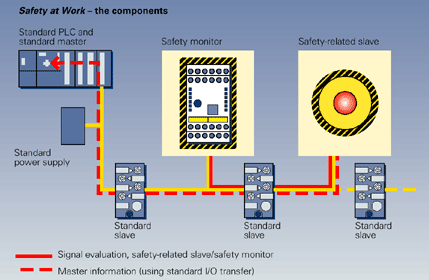
- Integration of all safety-relevant components in AS-Interface, such as
- EMERGENCY STOP
- Safety door switches
- Safety light barriers/grilles
- Contactor control etc.
- Mixed operation of standard and safety-relevant components on the yellow AS-Interface cable
- No failsafe PLC or no special master necessary due to setup with safety monitor
- Formation of safe signal groups possible within a network
- Diagnosis by standard-master/-PLC
System Properties
- Can be used up to control category 4 EN 954-1
Response time max. 35 ms
Certified by TÜV
Fully compatible with all other system components
AS-Interface components according to EN 50 295 and IEC 62026-2
Use of the standard AS-Interface protocol
Maximum expansion of the system with 31 safe slaves
Stop category 0 or 1 parameterizable
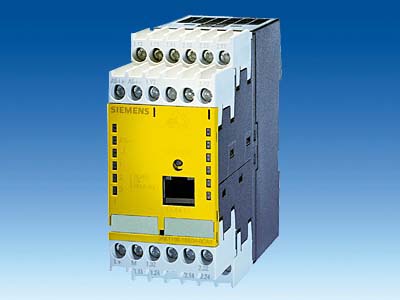 |
Safety Monitor
The safety monitor is the nucleus of Safety at Work. A safe application is configured with a PC. Different application-specific operating modes can be selected. These are for example, EMERGENCY STOP, holding closed, two-hand operation and the selection of stop category 0 or 1. The monitor can also be operated with AS-Interface address to fully expoit the AS-Interface diagnostics option.
|
 |
Enhanced Safety Monitor
The second version of the ASIsafe safety monitor with new functions supports implementation in complex applications. The work memory in the safety monitor has also been expanded. This allows complex applications to be configured in the safety monitor. Shorttime shutdowns are stored in a buffer for diagnostic purposes. The logical functions can be interlinked and cascaded. An additional timer identical to time relay on- and off-delay and pulse functions are now integrated.
|
 |
Safe Module K60F
The safe compact module K60F is fitted with 2 "safe" inputs. For operation up to category 2, both inputs can be separately assigned. If you require category 4, the module offers a two-channel input. The module also contains two unsafe standard outputs.
|
 |
Safe module K45F
The safe compact module K45F is fitted with 2 "safe" inputs. For operation up to category 2, both inputs can be separately assigned. If you require category 4, the module offers a two-channel input.
|

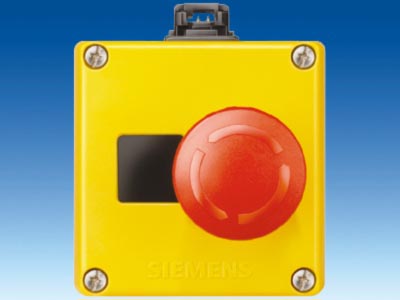 |
EMERGENCY STOP in encapsulations
AS-Interface-capable housing with 3SB3 command devices can be designed with safe connection of the EMERGENCY STOP device.
|
 |
SIGNUM EMERGENCY STOP
EMERGENCY STOP devices can now be connected directly via the standard AS-Interface with safety communication. This only applies for EMERGENCY STOP devices of SIGNUM 3SB3 command devices for front panel installation or installation in a housing. An EMERGENCY STOP device installed in a front panel can be connected directly to the AS-Interface by a safe module.
|
 |
SIGUARD light curtains and light grilles
The light curtains and light grilles of category 4 EN 954-1 offer active optical protection for persons working at machines. These are available as optional extras and can be connected directly and safely to the AS-Interface.
|
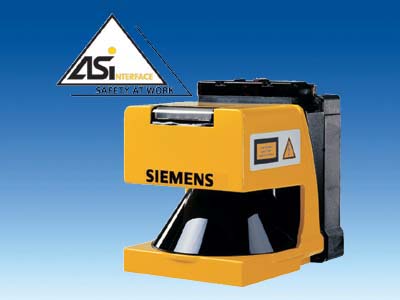 |
SIGUARD Laser Scanner
The SIGUARD laser scanner is an optical panoramic sensor for securing danger zones up to category 3 according to EN 954-1, which is also available with a safe AS-Interface connection.
|
 |
SIGUARD position switches
The SIGUARD position switches can now also be connected directly via the standard AS-Interface with safety communication. A special interface module is available for this which is mounted on the thread of a position switch. There is no longer any need for conventional wiring of the safety functions.
|
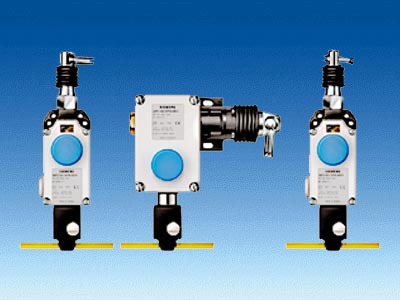 |
AS-Interface Cable-operated switches
Cable-operated switches are used for monitoring or for EMERGENCY-STOP facilities on particular endangered system sections. The AS-Interface cable-operated switches are implementable up to Category 4 to EN 954-1. As the effective range of a cable operated switch is limited by the length of the cord, large systems can also be protected.
|
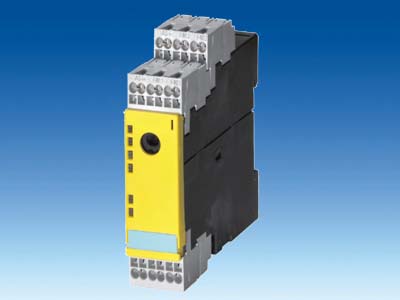 |
Slimline S22.5F
The successful product family of the "SlimLine" control cabinet modules has a new safe member. The safe flexible S22.5F input module supplements the new AS-Interface "SlimLine" control cabinet modules. This module series to the IP20 degree of protection creates space in the control cabinet or in the distributed local control box. The modules are of a narrow construction and are equipped with 2 inputs that reliably connect signals to the control cabinet. For operation up to Category 2, the two inputs can be separately assigned; if Category 4 is required, a twochannel input is available on the device.
|
More Information
Do you have any General Questions?
Are you looking for Additional Information?
Contact Us